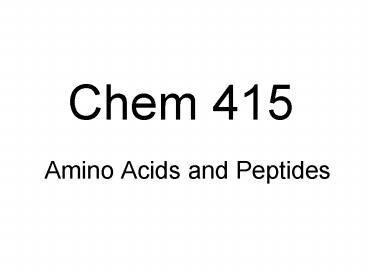Chem 415 Amino Acids and Peptides - PowerPoint PPT Presentation
1 / 11
Title:
Chem 415 Amino Acids and Peptides
Description:
... occur naturally and have a definite 3D structure under physiological conditions. ... Unique in that has the side chain pKa closest to Physiological pH ... – PowerPoint PPT presentation
Number of Views:28
Avg rating:3.0/5.0
Title: Chem 415 Amino Acids and Peptides
1
Chem 415 Amino Acids and Peptides
2
The Polypeptide backbone
- Peptide Short chain of residues with defined
sequence ltless than 10 chemistry defined by
residues - Polypeptide Longer chain of defined sequence and
lenghth 10gt lt50100. Chemistry may or may not be
defined by its residues - Polyamino acid Random sequence peptide of
undefined length
3
The Polypeptide backbone
- Protein Polypeptides that occur naturally and
have a definite 3D structure under physiological
conditions. chemistry is usually more than the
sum of its parts.
4
The Polypeptide backbone
5
Amino Acids
- Glycine
- Smallest AA
- Greatest backbone flexability
- Prechiral
- Protein environment is chiral so it is chiral in
proteins
- Aliphatic Residues
- Ala Val Leu Ile
- Innert carbon side chains
- Dont like water
- Provide much of the DG for protein folding
- Ile has two asymmetric centers
- Unreactive
6
Amino Acids
- Proline
- Cyclic Imino Acid
- 2 Amine group
- Often found in cis conformation
- Cis trans conversion is rate limiting in many
protein folds - Most restricted conformation in protiens
- Hydroxyl residues
- Ser and Thr
- Hydrophilic
- Found on protein exterior
- Hydrogen bond donor and acceptor
- May be acylated with Acid halides
- Thr has two asymetric centers
7
Amino Acids
- Acidic Residues
- Asp and Glu
- Provide general base general acid catalysis
- Hydrophilic
- H bond acceptors at physiological pH
- May be amidated through Carbodimide reaction.
- Ionization state in proteins may be determined by
reaction with Diazoamide or epoxides - Small difference in side chain length makes big
in structural behavior
8
Amino Acids
- Amide residues
- Asn Gln
- Amide derivatives of acid groups.
- H bond donor and acceptor
- Polar hydrophilic
- De amidation occurs over time (hydrolysis)
- N Term Gln Cyclizes
- Basic Residues
- Lys
- Hydrophilic
- Weak General acids
- Strong general base
- Good nucleophiles
- Lots of chemicals to label often used in cross
linking exp. - TNBS Maleic anhydride o-methyl isourea cyanate
- Reversibly forms shift bases with aldyhides
9
Amino Acids
- Basic Residues
- Arg
- Hydrophilic
- Weak General acid
- Reacts reversibly with 1,2 di-ones to form shifft
bases
- His
- Unique in that has the side chain pKa closest to
Physiological pH - Great general acid and general base catalyst
- Great nucleophile when unprotonated
- The most versatile of the amino acids
- Label with DEPC
10
Amino Acids
- Aromatic
- Phe Tyr Trp
- Non polar
- Responsible for 280 absorbance of proteins
http//www.proteinscience.org/cgi/reprint/4/11/241
1 - PheltTyrltTrp
- Tyr and Trp major contributers
- Aromatic
- Phe Tyr Trp
- Phe unreactive
- Tyr and Trp react with a variety of reagents
that label activated Aromatic rings
11
Amino Acids
- Met
- Non polar sulfur containing amino acid
- Reacts with CNBr then cyclizes to cleave peptide
bonds - reacts with alkylating agents
- Oxidized by molecular oxagen to sulfoxides then
sulfones. - Generally non reactive in proteins
- Cys
- Thiol containing amino acid
- easily alkylated
- Forms Disulfide linkages in proteins Cystine
- Will exchange with other sulfides
- Nucleophiles will cleave disulfides

